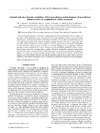Identificador persistente para citar o vincular este elemento:
https://accedacris.ulpgc.es/jspui/handle/10553/42304
| Título: | Classical molecular dynamics simulations of hydrogen plasmas and development of an analytical statistical model for computational validity assessment | Autores/as: | Gigosos, M. A. González-Herrero, D. Lara, N. Florido, R. Calisti, A. Ferri, S. Talin, B. |
Clasificación UNESCO: | 220410 Física de plasmas | Palabras clave: | Spectral-Line Shapes Coupled 2-Component Plasmas Code Comparison Workshop Ion-Dynamics Microscopic Simulation, et al. |
Fecha de publicación: | 2018 | Editor/a: | 2470-0045 | Proyectos: | Implementation of activities described in the Roadmap to Fusion during Horizon 2020 through a Joint programme of the members of the EUROfusion consortium | Publicación seriada: | Physical review. E | Resumen: | Classical molecular dynamics simulations of hydrogen plasmas have been performed with an emphasis on the analysis of the equilibration process. The theoretical basis of the simulation model as well as numerically relevant aspects, such as the proper choice and definition of simulation units, are discussed in detail, thus proving a thorough implementation of the computer simulation technique. Because of the lack of experimental data, molecular dynamics simulations are often considered as idealized computational experiments for benchmarking of theoretical models. However, these simulations are certainly challenging and consequently a validation procedure is also demanded. In this work we develop an analytical statistical equilibrium model for computational validity assessment of plasma particle dynamics simulations. Remarkable agreement between model and molecular dynamics results including a classical treatment of the ionization-recombination mechanism is obtained for a wide range of plasma coupling parameter values. Furthermore, the analytical model provides guidance to securely terminate simulation runs once the equilibrium stage has been reached, which in turn gives confidence in the statistics that potentially may be extracted from time histories of simulated physical quantities. | URI: | https://accedacris.ulpgc.es/handle/10553/42304 | ISSN: | 2470-0045 | DOI: | 10.1103/PhysRevE.98.033307 | Fuente: | Physical Review E [ISSN 2470-0045], v. 98 (3), (033307) |
| Colección: | Artículos |
Citas SCOPUSTM
10
actualizado el 08-jun-2025
Citas de WEB OF SCIENCETM
Citations
9
actualizado el 08-jun-2025
Visitas
102
actualizado el 27-jul-2024
Descargas
329
actualizado el 27-jul-2024
Google ScholarTM
Verifica
Altmetric
Comparte
Exporta metadatos
Los elementos en ULPGC accedaCRIS están protegidos por derechos de autor con todos los derechos reservados, a menos que se indique lo contrario.
